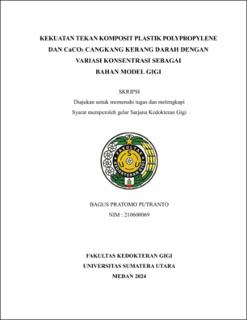Kekuatan Tekan Komposit Plastik Polypropylene dan CaCO3 Cangkang Kerang Darah dengan Variasi Konsentrasi sebagai Bahan Model Gigi
Compressive Strength of Polypropylene Plastic Composite and CaCO3 Blood Clam Shell with Variation of Concentration as Dental Model Material

Date
2024Author
Putranto, Bagus Pratomo
Advisor(s)
Harahap, Kholidina Imanda
Metadata
Show full item recordAbstract
Dental models as learning media are made of resin with lower hardness and strength than natural teeth. This affects the skills and tactile sensation during training procedures. Disposable use results in the accumulation of dental models in the environment because they cannot degrade naturally. In addition, polypropylene (PP) plastic food containers are widely produced because of their excellent properties. The use of blood cockles waste in dentistry has begun to be carried out because it has compounds similar to teeth in the form of 98% CaCO3. The innovation of polypropylene plastic with calcium carbonate filler can be an alternative raw material for making dental models. This study aimed to analyze the compressive strength of polypropylene plastic composites and CaCO3 blood clam shells with varying concentrations as dental model materials. This study used samples made from polypropylene plastic composites and CaCO3 blood coockles (Anadara granosa) with a comparison in group 1 (75:25), group 2 (83:17), and group 3 (88:12) (n = 10). CaCO3 powder has been confirmed to come from blood clam shells made through a demineralization process using 15% acetic acid, dried, then ground and sieved with Particle Size Analyzer (PSA) results showing an average particle size of 0.35 μm. For polypropylene plastic, it is cut into 1-2 cm and melted in an oven at 1600C for 20 minutes. The melted plastic is stirred with CaCO3 powder until homogeneous on an electric stove. The composite is poured into a mould and pressed using a 60-bar hydraulic press for 5 minutes. The sample is removed and prepared to obtain a tube-shaped sample with a size of 10x10x20 mm. The compressive strength test was carried out using a Universal Testing Machine. Data were analyzed using the One-Way ANOVA and Post Hoc Least Significant Different (LSD) tests. The results showed the average compressive strength value in group 2 (27.91 ± 1.44 MPa), followed by group 3 (23.20 ± 1.24 MPa) and group 1 (17.59 ± 1.31 MPa). The data were normally distributed and analyzed using the One-Way ANOVA test, showing that there was a significant difference in compressive strength with p = 0.0001, and the highest strength value was found in the composite of group 2. It can be concluded that the composite of polypropylene plastic and CaCO3 blood clam shells with a ratio of 75:25, 83:17, and 88:12 has a significant difference in compressive strength with the best compressive strength value in group 2 (83:17).
Collections
- Undergraduate Theses [1908]
